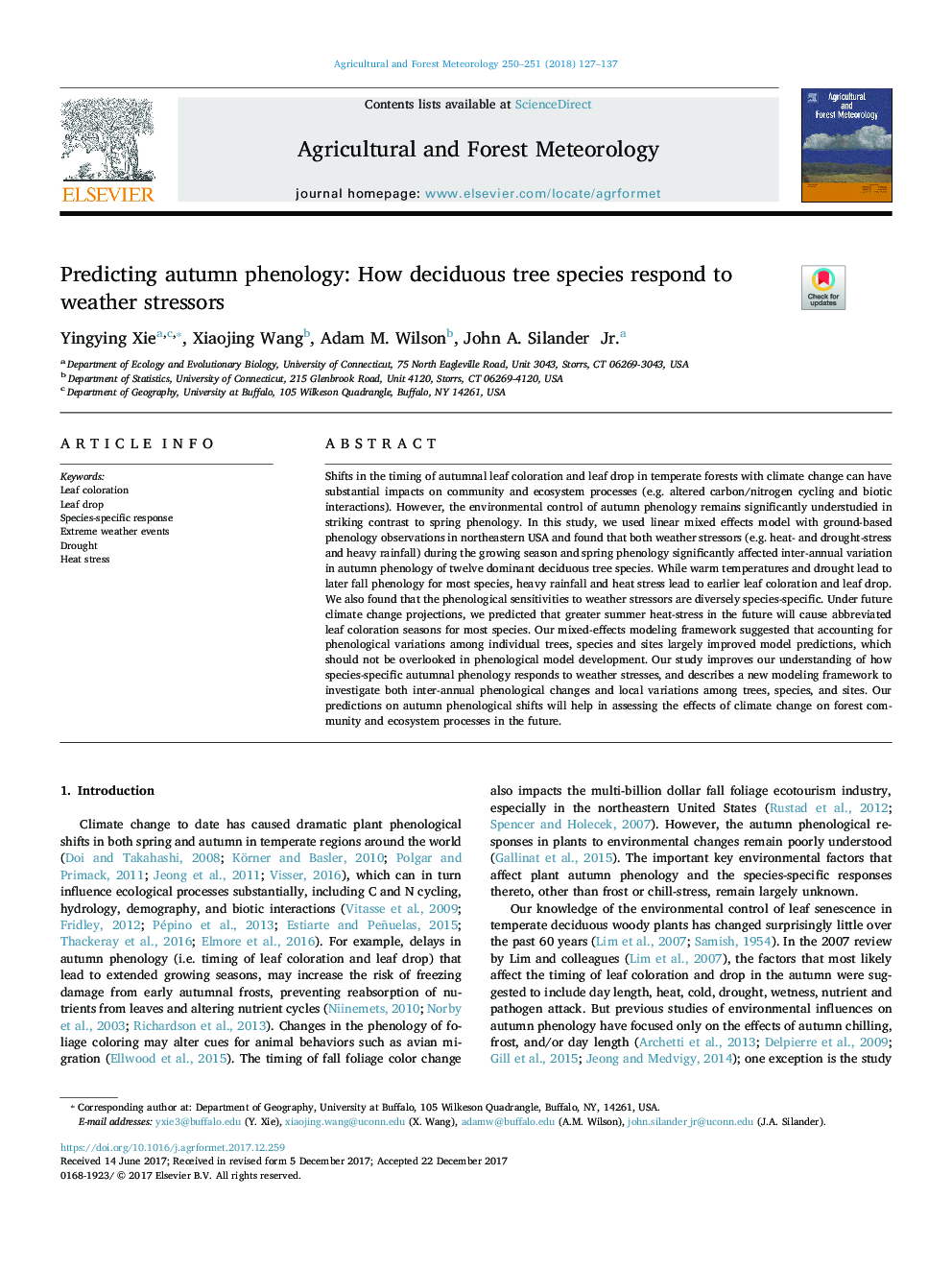| کد مقاله | کد نشریه | سال انتشار | مقاله انگلیسی | نسخه تمام متن |
|---|---|---|---|---|
| 6536798 | 1420851 | 2018 | 11 صفحه PDF | دانلود رایگان |
عنوان انگلیسی مقاله ISI
Predicting autumn phenology: How deciduous tree species respond to weather stressors
ترجمه فارسی عنوان
پیش بینی فنولوژی پاییز: چگونه گونه های درخت چینی به عوامل استرس زا پاسخ می دهند
دانلود مقاله + سفارش ترجمه
دانلود مقاله ISI انگلیسی
رایگان برای ایرانیان
کلمات کلیدی
رنگ برگ افت برگ پاسخ خاص گونه حوادث شدید آب و هوا، خشکی، استرس گرما،
ترجمه چکیده
تغییرات در زمان رنگ برگ برگ پاییز و کاهش برگ در جنگل های معتدل با تغییرات آب و هوایی می تواند تاثیرات قابل توجهی بر روند های اجتماعی و اکوسیستم داشته باشد (مثلا تغییر دوچرخه کربن / نیتروژن و تعاملات زیستی). با این حال، کنترل زیست محیطی فنولوژی پاییز همچنان به طور قابل ملاحظه ای در مقایسه با فنولوژی بهار به نظر می رسد. در این مطالعه، از مدل خطی مخلوط با استفاده از مشاهدات فنولوژیکی زمین در شمال شرقی ایالات متحده آمریکا استفاده شده است و دریافتند که هر دو عوامل تنش زا (مانند گرما و خشکی و بارندگی سنگین) در طول فصل رشد و فنولوژی بهار به طور معنی داری بر تغییرات سالانه در فنولوژی پاییزی از دوازده گونه درختان برگی غالب در حالی که دمای هوای گرم و خشکسالی به علت سقوط فنولوژیک برای اکثر گونه ها، بارندگی سنگین و استرس گرما منجر به رنگ برگ زودتر و افت برگ می شود. همچنین ما دریافتیم که حساسیت فنولوژیکی به عوامل استرس زا به صورت گونه ای متفاوت است. پیش بینی های تغییرات آب و هوایی آینده ما پیش بینی کردیم که گرمادهی تابستان بیشتر در آینده سبب کوتاه شدن برگ های برگ در بیشتر گونه ها خواهد شد. چارچوب مدل سازی ترکیبی اثرات ما نشان داد که حسابداری تنوع فنولوژیکی درختان، گونه ها و مکان های مختلف به طور چشمگیری پیش بینی های مدل را بهبود می بخشد، که نباید در طراحی مدل فنولوژیک مورد توجه قرار گیرد. مطالعه ما درک ما را در مورد اینکه چگونه فنولوژی نسوز مخصوص گونه ها به تنش های آب و هوایی پاسخ می دهد، بهبود می بخشد و چارچوب مدل سازی جدید را برای بررسی هر دو تغییرات فنولوژیک سالانه و تغییرات محلی درختان، گونه ها و مکان ها توصیف می کند. پیش بینی های ما در مورد تغییرات فنولوژیک پاییز در ارزیابی اثرات تغییرات اقلیمی در جامعه جنگل و فرایندهای اکوسیستم در آینده کمک خواهد کرد.
موضوعات مرتبط
مهندسی و علوم پایه
علوم زمین و سیارات
علم هواشناسی
چکیده انگلیسی
Shifts in the timing of autumnal leaf coloration and leaf drop in temperate forests with climate change can have substantial impacts on community and ecosystem processes (e.g. altered carbon/nitrogen cycling and biotic interactions). However, the environmental control of autumn phenology remains significantly understudied in striking contrast to spring phenology. In this study, we used linear mixed effects model with ground-based phenology observations in northeastern USA and found that both weather stressors (e.g. heat- and drought-stress and heavy rainfall) during the growing season and spring phenology significantly affected inter-annual variation in autumn phenology of twelve dominant deciduous tree species. While warm temperatures and drought lead to later fall phenology for most species, heavy rainfall and heat stress lead to earlier leaf coloration and leaf drop. We also found that the phenological sensitivities to weather stressors are diversely species-specific. Under future climate change projections, we predicted that greater summer heat-stress in the future will cause abbreviated leaf coloration seasons for most species. Our mixed-effects modeling framework suggested that accounting for phenological variations among individual trees, species and sites largely improved model predictions, which should not be overlooked in phenological model development. Our study improves our understanding of how species-specific autumnal phenology responds to weather stresses, and describes a new modeling framework to investigate both inter-annual phenological changes and local variations among trees, species, and sites. Our predictions on autumn phenological shifts will help in assessing the effects of climate change on forest community and ecosystem processes in the future.
ناشر
Database: Elsevier - ScienceDirect (ساینس دایرکت)
Journal: Agricultural and Forest Meteorology - Volumes 250â251, 15 March 2018, Pages 127-137
Journal: Agricultural and Forest Meteorology - Volumes 250â251, 15 March 2018, Pages 127-137
نویسندگان
Yingying Xie, Xiaojing Wang, Adam M. Wilson, John A. Jr.,
